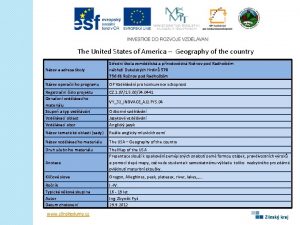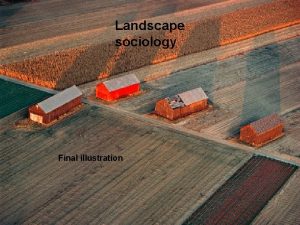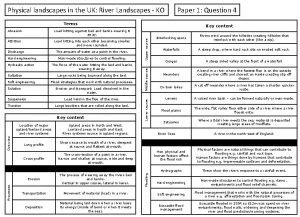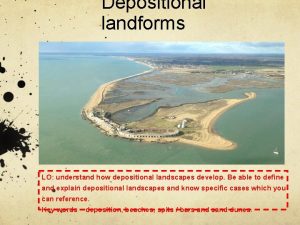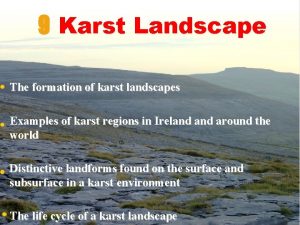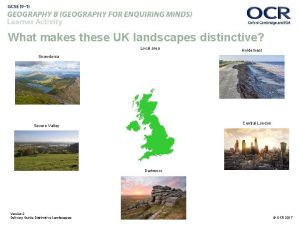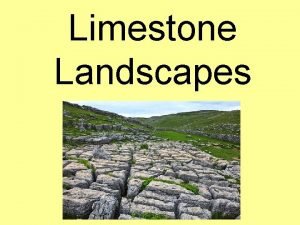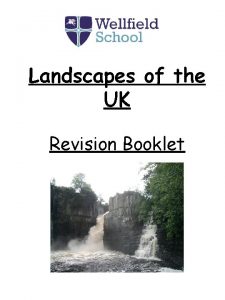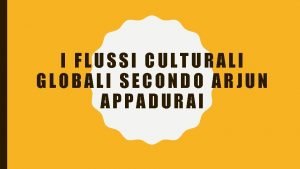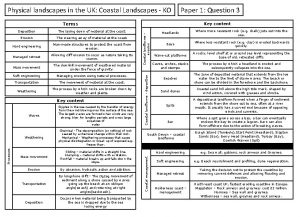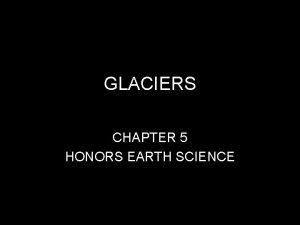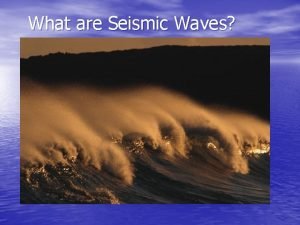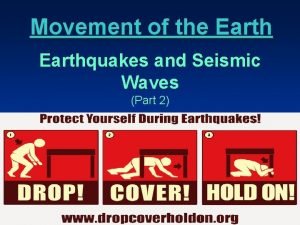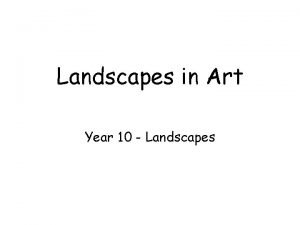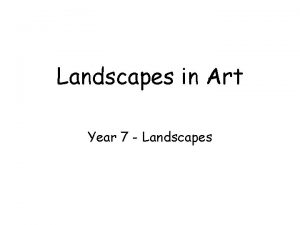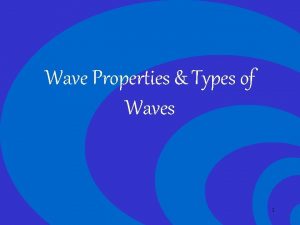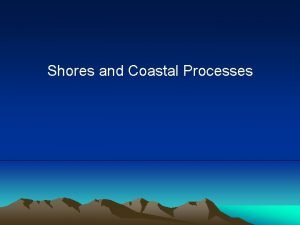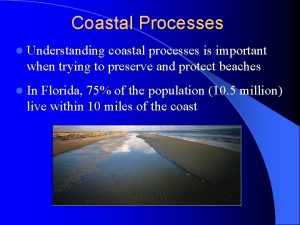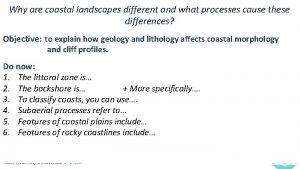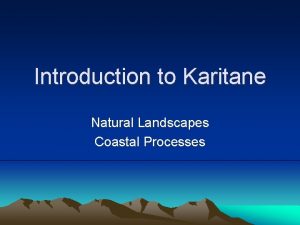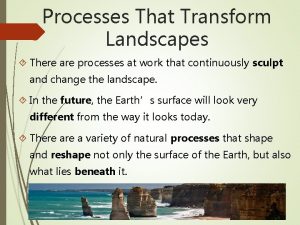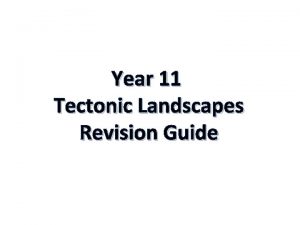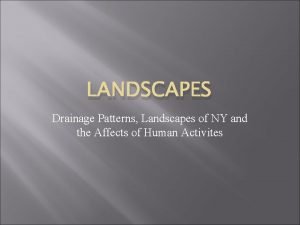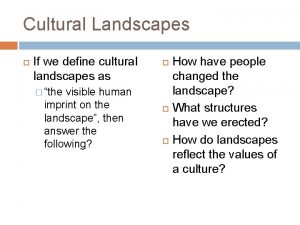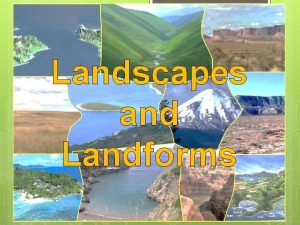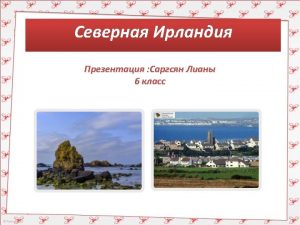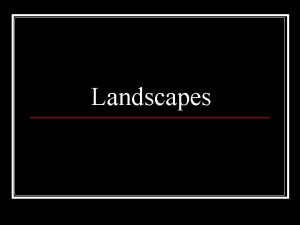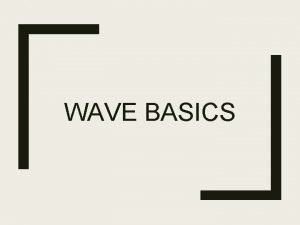Coastal Landscapes Coastal processes 1 Types of wave


























![2 - Slumping [rotational slipping] Involves a large area of land moving down a 2 - Slumping [rotational slipping] Involves a large area of land moving down a](https://slidetodoc.com/presentation_image_h2/6c4e5763fedb00966f11f2769792999f/image-27.jpg)


- Slides: 29

Coastal Landscapes Coastal processes 1

Types of wave: constructive and destructive. Learning objectives: • Describe the characteristics of the two wave types. • Explain their impact on beach profiles. Waves are produced by wind blowing across the surface of the water. 2

Why does wave energy vary? The energy of a wave depends on: the velocity of the wind how long the wind blows the fetch which is the length of water the wind blows over. The stronger the wind is, the longer it blows for and the longer the fetch the larger the waves will be and the more energy they’ll have! • -

FETCH Suggest how wave fetch can cause different rates of coastal recession. (3) Fetch: The length of water the wind blows over. Longer distance waves have more energy (1), more power to erode (1), increasing hydraulic action/abrasion (1).

Key words Swash and backwash When waves break, water rushes up the beach due to the energy from the wave. This is called the swash. When the water has lost its energy further up the beach, it runs down again, under gravity. This is called the backwash. 5

WAVE TERMINOLOGY Wave length is the average distance between successive wave crests. Wave height is the vertical distance between a wave trough and a wave crest. 6

Destructive waves http: //www. youtube. com/watch? v=7 wo. VTu. N 8 k 3 c&feature=related

Destructive waves lower the beach gradient in its lower section 8

Constructive waves 9

Constructive waves 10

Differences between the two types of waves Compare the characteristics of constructive and destructive waves. (4) Destructive waves have a greater backwash than swash (1) compared to constructive waves due to their higher energy (1) meaning that they can erode beaches (1). Constructive waves have a lower frequency (1) as a result of their longer wavelength (1) Destructive waves are plunging whereas constructive are surging (1). Destructive waves are higher (>1 m) compared with constructive (1). 11

Impact on beach profile Constructive waves Destructive waves Process Sand shingle moved up the beach = deposition Most material is carried downward by the backwash= erosion Impact on beach profile Sediment is being added to the beach which the backwash cannot entirely remove, producing a gentle build-up of beach material. This will increase the gradient of the beach in its lower section. Due to erosion, beach profile becomes gentler in its lower section. 12

Revision Draw diagrams of constructive and destructive waves and label these to contrast the beach profiles and wave height/wave length. 13

Types of erosion, weathering and mass movement Learning objectives Define and explain the different types of weathering, erosion and mass movement. Watch: http: //www. youtube. com/watch? v=z Uh 3 Weil. FN 4 14

Processes of erosion (i) Hydraulic action: As the water gets into cracks in the rock face, it compresses the air in the cracks; this puts even more pressure on the cracks and pieces of rock may break off. (ii) Corrasion [abrasion]: sand pebbles carried within waves are thrown against the cliff face and particles of rocks are broken off. (iii) Corrosion [solution]: chemical reaction between rocks made of calcium carbonate and salt and other acids in seawater. (iv) Attrition: as the boulders in the sea continually roll around, they chip away at each, become smaller, smoother and more rounded. Final material: sand. 15

16

17

18

Cross-section diagram of a chalk cliff Weathering and mass movement Coastal erosion Tidal range

Explain how the type of rock (geology) and structure can affect the rate of coastal erosion. (4) Rock type - if the cliffs are made from resistant rock, (1) like granite or limestone and chalk, (1) they will erode more slowly than cliffs made from less resistant rock, (1) such as clay. Rock structure - the rock’s structure can also have an effect on the rate of erosion. Rocks that are well jointed (1) or with many faults, (1) such as limestone and chalk, (1) will erode more quickly (1) as the waves exploit these lines of weakness. (1)

Sub-aerial processes: work on the cliff face 1 - Weathering 2 - Mass movement 21

WEATHERING Weathering is the breaking or the decomposition of rocks in situ. 22

Outline of main types of weathering Physical weathering: water expands when changed into ice expansion puts pressure on the rock around it fragments of rock break off. Chemical weathering: weak acids in rainwater react with calcium carbonate in rocks break up or dissolve. Biological weathering: plants grow in cracks roots break up rocks may cause cliff collapse. 23

Mass movement Definition: When material moves down a slope due to the pull of gravity. 1 - Soil creep: very slow movement, very little impact on landformation. 2 - Slumping: great impact on clay cliffs 24

Soil creep (the slowest downhill movement of soil 2 -The soil moves downhill with the water. 3 -The slope appears rippled. 1 -Gravity pulls the water that is contained in the soil down a slope 25

Soil creep 26
![2 Slumping rotational slipping Involves a large area of land moving down a 2 - Slumping [rotational slipping] Involves a large area of land moving down a](https://slidetodoc.com/presentation_image_h2/6c4e5763fedb00966f11f2769792999f/image-27.jpg)
2 - Slumping [rotational slipping] Involves a large area of land moving down a slope. Very common on clay cliffs. Clay dries and cracks in summer When it rains, water runs into cracks absorbs by clay which becomes saturated clay slips down. 27

Slumping 28

Outline how mass movement impacts on coastal landforms. (3) Wave action/sea/rain cause the cliffs to become saturated (1), if made of clay (1). Over time the material in the cliff becomes weakened and subject to gravity (1) cliff material slides down thereby removing material (1). Landslides can cause rapid removal of coastal material / loss of land (1). Soil creep causes slow removal of soil from coastal slopes (1); ridges / ripples are left (1). Slumping causes a downward moment of material (1) this leaves a curved shape (1).
 Coastal landscapes a level geography
Coastal landscapes a level geography Biosphere definition biology
Biosphere definition biology Concurrent in os
Concurrent in os Uk physical landscapes
Uk physical landscapes Fpm landscapes
Fpm landscapes Define depositional landforms
Define depositional landforms Karst landscape examples ireland
Karst landscape examples ireland What makes a landscape distinctive
What makes a landscape distinctive Limestone landscapes
Limestone landscapes Landscapes and landforms booklet
Landscapes and landforms booklet Mediorami
Mediorami Landscapes and landforms
Landscapes and landforms Morraine glacier
Morraine glacier Light and sound travel in waves true or false
Light and sound travel in waves true or false Short wave vs long wave radiation
Short wave vs long wave radiation Difference between full wave and half wave rectifier
Difference between full wave and half wave rectifier Transverse and longitudinal waves both *
Transverse and longitudinal waves both * Define half wave rectifier
Define half wave rectifier Full wave bridge rectifier with center tapped transformer
Full wave bridge rectifier with center tapped transformer Earthquake p-wave and s-wave travel time graph
Earthquake p-wave and s-wave travel time graph Rectified sine wave fourier series
Rectified sine wave fourier series A ____ is a repeating disturbance or movement that
A ____ is a repeating disturbance or movement that The wave chapter 10
The wave chapter 10 Quarter wave symmetry
Quarter wave symmetry Mechanical waves and electromagnetic waves
Mechanical waves and electromagnetic waves Characteristics of mechanical waves
Characteristics of mechanical waves Transverse wave and longitudinal wave example
Transverse wave and longitudinal wave example Morphological processes examples
Morphological processes examples Seismic wave types
Seismic wave types Seismic wave types
Seismic wave types
